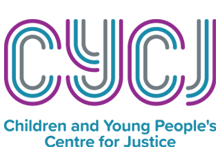Four youth justice professionals wore an electronic tag for a week, to raise awareness and understanding of electronic monitoring (tagging) and how MRCs (movement restriction conditions) can be used, in a CYCJ led initiative.
Neil Hunter, Principal Reporter/Chief Executive of the Scottish Children’s Reporter Administration (SCRA) and Paolo Mazzoncini, Chief Social Work Officer for East Dunbartonshire, volunteered themselves to be ‘tagged’ by G4S during October.
They were joined by Donna McEwan, Practice Development Advisor with CYCJ and Fern Gillon, who is studying for her PhD in Law, Crime and Justice at the University of Strathclyde and is also a Children’s Panel member.
This initiative followed on from the Scottish Government’s official approval in October of all seven recommendations made to the Cabinet Secretary for Justice on the use of electronic monitoring. In the same month, CYCJ published its report exploring how MRCs are being used through the Children’s Hearing System and how they could be better used in the future.
All four volunteers were subject to the usual curfews and restrictions of a tagging order, and required to discuss any breaches with G4S. They were asked to record their experiences and thoughts, which were shared on the CYCJ website as blogs and video recordings.
Once an individual is tagged, he/she must stick to the curfew imposed. If this is breached, a call will be made by G4S and the order could be revoked, potentially resulting in a custodial sentence or in the case of a young person, secure care. Currently there are moves to use electronic monitoring as an alternative to short-term prison sentences and as an alternative to remand.
You can read the volunteers’ blogs here:
An insight into life with a tag: Neil Hunter
Taking a (short) walk in their shoes: Donna McEwan
Diary of an electronic tag: Paolo Mazzoncini
MRCS – fit for purpose?: Fern Gillon
To join the conversation, please email cycj@strath.ac.uk or call 0141 444 8622.

